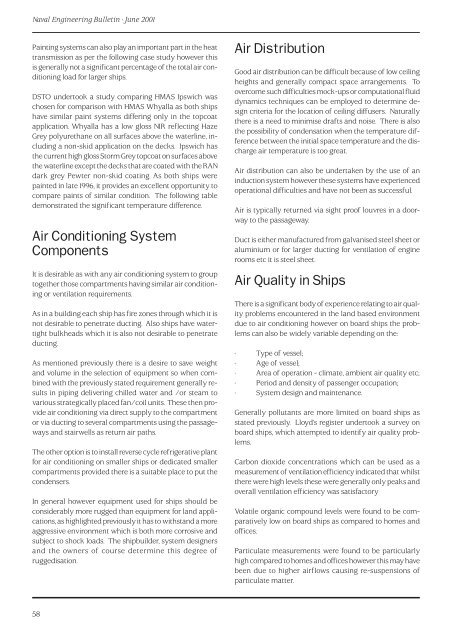Engineering - Royal Australian Navy
Engineering - Royal Australian Navy
Engineering - Royal Australian Navy
You also want an ePaper? Increase the reach of your titles
YUMPU automatically turns print PDFs into web optimized ePapers that Google loves.
Naval <strong>Engineering</strong> Bulletin • June 2001<br />
Painting systems can also play an important part in the heat<br />
transmission as per the following case study however this<br />
is generally not a significant percentage of the total air conditioning<br />
load for larger ships.<br />
DSTO undertook a study comparing HMAS Ipswich was<br />
chosen for comparison with HMAS Whyalla as both ships<br />
have similar paint systems differing only in the topcoat<br />
application. Whyalla has a low gloss NIR reflecting Haze<br />
Grey polyurethane on all surfaces above the waterline, including<br />
a non-skid application on the decks. Ipswich has<br />
the current high gloss Storm Grey topcoat on surfaces above<br />
the waterline except the decks that are coated with the RAN<br />
dark grey Pewter non-skid coating. As both ships were<br />
painted in late 1996, it provides an excellent opportunity to<br />
compare paints of similar condition. The following table<br />
demonstrated the significant temperature difference.<br />
Air Conditioning System<br />
Components<br />
It is desirable as with any air conditioning system to group<br />
together those compartments having similar air conditioning<br />
or ventilation requirements.<br />
As in a building each ship has fire zones through which it is<br />
not desirable to penetrate ducting. Also ships have watertight<br />
bulkheads which it is also not desirable to penetrate<br />
ducting.<br />
As mentioned previously there is a desire to save weight<br />
and volume in the selection of equipment so when combined<br />
with the previously stated requirement generally results<br />
in piping delivering chilled water and /or steam to<br />
various strategically placed fan/coil units. These then provide<br />
air conditioning via direct supply to the compartment<br />
or via ducting to several compartments using the passageways<br />
and stairwells as return air paths.<br />
The other option is to install reverse cycle refrigerative plant<br />
for air conditioning on smaller ships or dedicated smaller<br />
compartments provided there is a suitable place to put the<br />
condensers.<br />
In general however equipment used for ships should be<br />
considerably more rugged than equipment for land applications,<br />
as highlighted previously it has to withstand a more<br />
aggressive environment which is both more corrosive and<br />
subject to shock loads. The shipbuilder, system designers<br />
and the owners of course determine this degree of<br />
ruggedisation.<br />
Air Distribution<br />
Good air distribution can be difficult because of low ceiling<br />
heights and generally compact space arrangements. To<br />
overcome such difficulties mock-ups or computational fluid<br />
dynamics techniques can be employed to determine design<br />
criteria for the location of ceiling diffusers. Naturally<br />
there is a need to minimise drafts and noise. There is also<br />
the possibility of condensation when the temperature difference<br />
between the initial space temperature and the discharge<br />
air temperature is too great.<br />
Air distribution can also be undertaken by the use of an<br />
induction system however these systems have experienced<br />
operational difficulties and have not been as successful.<br />
Air is typically returned via sight proof louvres in a doorway<br />
to the passageway.<br />
Duct is either manufactured from galvanised steel sheet or<br />
aluminium or for larger ducting for ventilation of engine<br />
rooms etc it is steel sheet.<br />
Air Quality in Ships<br />
There is a significant body of experience relating to air quality<br />
problems encountered in the land based environment<br />
due to air conditioning however on board ships the problems<br />
can also be widely variable depending on the:<br />
• Type of vessel;<br />
• Age of vessel;<br />
• Area of operation - climate, ambient air quality etc;<br />
• Period and density of passenger occupation;<br />
• System design and maintenance.<br />
Generally pollutants are more limited on board ships as<br />
stated previously. Lloyd’s register undertook a survey on<br />
board ships, which attempted to identify air quality problems.<br />
Carbon dioxide concentrations which can be used as a<br />
measurement of ventilation efficiency indicated that whilst<br />
there were high levels these were generally only peaks and<br />
overall ventilation efficiency was satisfactory<br />
Volatile organic compound levels were found to be comparatively<br />
low on board ships as compared to homes and<br />
offices.<br />
Particulate measurements were found to be particularly<br />
high compared to homes and offices however this may have<br />
been due to higher airflows causing re-suspensions of<br />
particulate matter.<br />
58
















